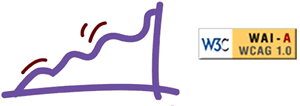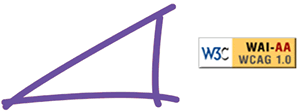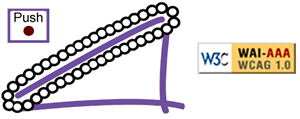You may be asked what accessibility level your site conforms to, or you may have to specify the level you want in tender documents*. This article provides an easy way to think about the accessibility levels of the most internationally recognised accessibility standard – it will more than likely be the one you will use too (or if not your standard will probably be derived from it).
* Tip: you should go for a minimum of double-A compliance, find out what this means below
WAI accessibility conformance and priority levels
The World Wide Web Consortium (W3C) is the body responsible for setting Internet and Web standards. The Web Accessibility Initiative (WAI) is part of the W3C and is responsible for promoting and supporting accessibility.
WAI guidelines and priorities
WAI provide documents and resources to assist with improvements in accessibility. The guideline document that applies to the production of web pages is the Web Content Accessibility Guidelines version 1.0 (WCAG 1.0). This comprises 14 guidelines split into 65 separate checkpoints. The checkpoints are classified into 3 priority levels according to their impact on accessibility. WAI describe the priorities as below:
Priority 1
A Web content developer must satisfy this checkpoint. Otherwise, one or more groups will find it impossible to access information in the document. Satisfying this checkpoint is a basic requirement for some groups to be able to use Web documents.
Priority 2
A Web content developer should satisfy this checkpoint. Otherwise, one or more groups will find it difficult to access information in the document. Satisfying this checkpoint will remove significant barriers to accessing Web documents.
Priority 3
A Web content developer may address this checkpoint. Otherwise, one or more groups will find it somewhat difficult to access information in the document. Satisfying this checkpoint will improve access to Web documents.
WAI accessibility conformance levels
Reaching a certain level of accessibility commensurate with the WAI guidelines and priority levels is often referred to in documents, such as policy documents, requirements documents or tender documents. Unfortunately the nomenclature surrounding this can be quite confusing and the incorrect terms are often used. Below are shown the terms as specified by the WAI but expect to see a mix of terms in documents you come across, for example, conformance level WAI-A (single A compliance to the WAI Web Content Accessibility Guidelines version 1.0) will often be referred to as W3C priority 1, or WAI level 1.
Implementing the checkpoints confers different accessibility conformance levels depending on the priorities passed. Achieving a conformance level entitles the site to display a WAI conformance icon.
![]()
Checkpoints passed:All priority 1, Conformance level: Single-A (WAI-A)
![]()
Checkpoints passed: All priority 1 and 2, Conformance level: Double-A (WAI-AA)
![]()
Checkpoints passed: All checkpoints (1,2 and 3), Conformance level: Triple-A (WAI-AAA)
A way to think about conformance levels
Imagine a building with an access ramp. The ease with which the ramp facilitates users who depend upon it can be considered analogous to the conformance levels:







